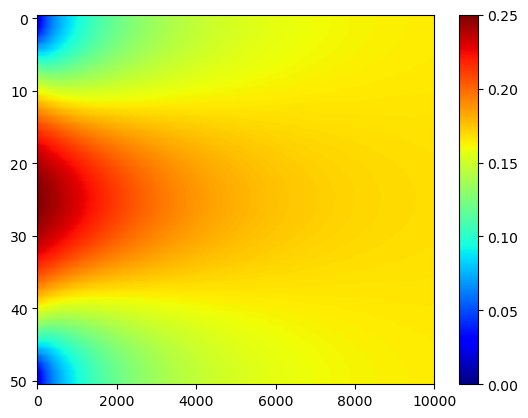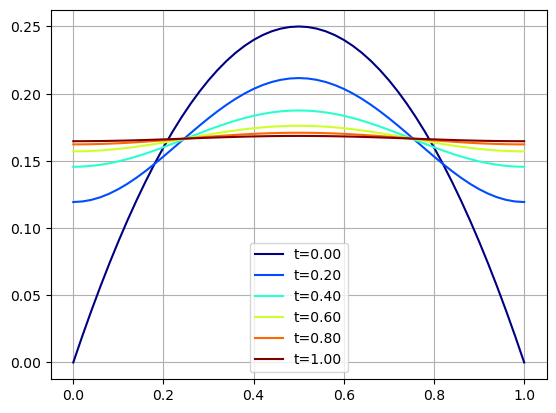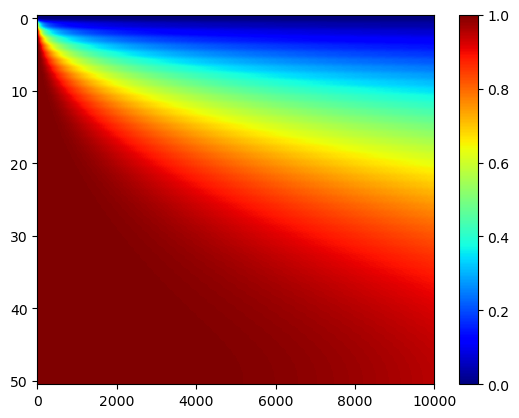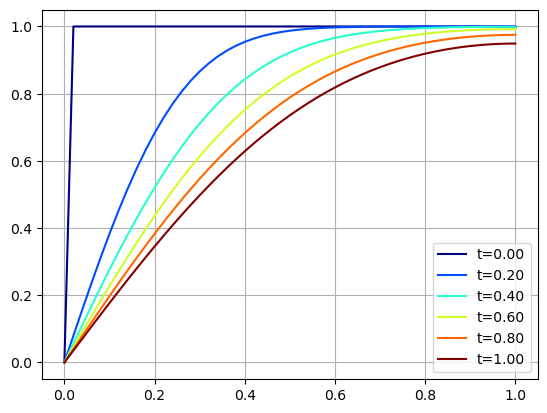Heat Equation#
import numpy as np
import matplotlib.pyplot as plt
The heat equation (or diffusion equation) is given by
Initial and Boundary Conditions#
The initial condition is a function \(f(x)\) which determines the solution \(u(x,0) = f(x)\) at time \(t=0\).
Dirichlet boundary conditions specify the values of the solution at the endpoints:
Neumann boundary conditions specify the values of the derivative of the solution at the endpoints:
When one endpoint is a Dirichlet boundary condition and the other is a Neumann boundary condition then we call them mixed boundary conditions. For example:
Discretization#
Choose the number of steps \(N\) in the \(x\) direction and the number of steps \(K\) in the \(t\) direction. These choices determine the step sizes \(\Delta x\) and \(\Delta t\), and create a grid of points:
Here we have chosen some final time value \(t_f\) so that the domain of the solution \(u(x,t)\) is a finite rectangle \([0,L] \times [0,t_f]\). The goal of a finite difference method is to compute the matrix
which gives approximations of the solution \(u(x,t)\) at the grid points:
where \(x_0 = 0\), \(x_N = L\), \(t_0 = 0\) and \(t_K = t_f\).
Forward Time Central Space#
Apply the forward difference formula for \(u_t\) at position \(x_n\) and time \(t_k\)
Apply the central difference formula for \(u_{xx}\) at position \(x_n\) and time \(t_k\)
Plug the formulas into the heat equation at position \(x_n\) and time \(t_k\)
Rearrange to solve for \(u_{n,k+1}\)
This is the forward-time-central-space (FTCS) finite difference method for the heat equation.
FTCS with Dirichlet BCs#
Matrix Equations#
Consider Dirichlet boundary conditions \(u(0,t) = T_0\) and \(u(L,t)\). Let \(u_{0,k} = T_0\) and \(u_{N,k} = T_L\) for all \(k\) and write out the FTCS equations for \(n=1,\dots,N-1\) along with the boundary conditions \(u_{0,k+1} = u_{0,k}\) and \(u_{N,k+1} = u_{N,k}\):
These finite difference equations show us that approximations at time \(t_{k+1}\) are given by matrix multiplication of the vector of approximations at time \(t_k\). Therefore we can write the FTCS method as an iterative matrix formula.
where
The algorithm produces the matrix of approximations
starting from the initial condition
Note that we can create the matrix \(A\) with a for loop. For example:
N = 5
r = 0.01
A = np.zeros((N+1,N+1))
A[0,0] = 1
A[N,N] = 1
for n in range(1,N):
A[n,n-1] = r
A[n,n] = 1 - 2*r
A[n,n+1] = r
print(A)
[[1. 0. 0. 0. 0. 0. ]
[0.01 0.98 0.01 0. 0. 0. ]
[0. 0.01 0.98 0.01 0. 0. ]
[0. 0. 0.01 0.98 0.01 0. ]
[0. 0. 0. 0.01 0.98 0.01]
[0. 0. 0. 0. 0. 1. ]]
Implementation#
The function heatFTCSD takes input parameters alpha, L, f, T0, TL, tf, N and K, and returns the matrix U of approximations where:
alphais the diffusion coefficient in the heat equation \(u_t = \alpha^2 u_{xx}\)Lis the length of the interval \(0 \leq x \leq L\)fis a Python function whcih represents the initial condition \(u(x,0) = f(x)\)T0is the boundary condition \(u(0,t) = T_0\)TLis the boundary condition \(u(L,t) = T_L\)tfis the length of the interval \(0 \leq t \leq t_f\)Nis the number of steps in the \(x\)-direction of the discretizationKis the number of steps in the \(t\)-direction of the discretizationUis the matrix \(U = [u_{n,k}]\) of size \((N+1) \times (K+1)\) of approximations \(u_{n,k} \approx u(x_n,t_k)\)
def heatFTCSD(alpha,L,f,T0,TL,tf,N,K):
dx = L/N
dt = tf/K
x = np.linspace(0,L,N+1)
U = np.zeros((N+1,K+1))
U[:,0] = f(x)
U[0,0] = T0
U[N,0] = TL
r = alpha*dt/dx**2
A = np.zeros((N+1,N+1))
A[0,0] = 1
A[N,N] = 1
for n in range(1,N):
A[n,n-1] = r
A[n,n] = 1 - 2*r
A[n,n+1] = r
for k in range(K):
U[:,k+1] = A@U[:,k]
return U
Example#
Consider \(\alpha = 0.1\), \(L = 1\), \(f(x) = x(1-x)\), \(T_0 = 0\), \(T_L\) and \(t_f = 1\).
alpha = 0.1
L = 1
f = lambda x: x*(1 - x)
T0 = 0
TL = 0
tf = 1
N = 50
K = 1000
U = heatFTCSD(alpha,L,f,T0,TL,tf,N,K)
plt.imshow(U,aspect='auto',cmap='jet')
plt.colorbar()
plt.show()

FTCS with Neumann BCs#
Matrix Equations#
Consider Neumann boundary conditions \(u_x(0,t) = Q_0\) and \(u_x(L,t) = Q_L\). The FTCS finite difference equation at \(n=0\) yields
with the “ghost value” \(u_{-1,k}\). Use the central difference formula for \(u_x(0,t_k) = Q_0\)
Rearrange for \(u_{-1,k}\)
and substitute into the FTCS equation
Similarly, the boundary condition \(u_x(L,t) = Q_L\) yields the equation
Write out the FTCS equations for \(n=1,\dots,N-1\) along with the boundary conditions:
These finite difference equations show us that approximations at time \(t_{k+1}\) are given by matrix multiplication of the vector of approximations at time \(t_k\). Therefore we can write the FTCS method as an iterative matrix formula.
where
The algorithm produces the matrix of approximations
starting from the initial condition
Implementation#
The function heatFTCSN takes input parameters alpha, L, f, Q0, QL, tf, N and K, and returns the matrix U of approximations where:
alphais the diffusion coefficient in the heat equation \(u_t = \alpha^2 u_{xx}\)Lis the length of the interval \(0 \leq x \leq L\)fis a Python function whcih represents the initial condition \(u(x,0) = f(x)\)Q0is the boundary condition \(u_x(0,t) = Q_0\)QLis the boundary condition \(u_x(L,t) = Q_L\)tfis the length of the interval \(0 \leq t \leq t_f\)Nis the number of steps in the \(x\)-direction of the discretizationKis the number of steps in the \(t\)-direction of the discretizationUis the matrix \(U = [u_{n,k}]\) of size \((N+1) \times (K+1)\) of approximations \(u_{n,k} \approx u(x_n,t_k)\)
def heatFTCSN(alpha,L,f,Q0,QL,tf,N,K):
dx = L/N
dt = tf/K
x = np.linspace(0,L,N+1)
U = np.zeros((N+1,K+1))
U[:,0] = f(x)
r = alpha*dt/dx**2
A = np.zeros((N+1,N+1))
A[0,0] = 1 - 2*r
A[0,1] = 2*r
A[N,N] = 1 - 2*r
A[N,N-1] = 2*r
for n in range(1,N):
A[n,n-1] = r
A[n,n] = 1 - 2*r
A[n,n+1] = r
q = np.zeros(N+1)
q[0] = -2*alpha**2*dt/dx*Q0
q[N] = 2*alpha**2*dt/dx*QL
for k in range(K):
U[:,k+1] = A@U[:,k] + q
return U
Example#
Consider \(\alpha = 0.1\), \(L = 1\), \(f(x) = x(1-x)\), \(Q_0=Q_L=0\) and \(t_f = 1\).
alpha = 0.1
L = 1
f = lambda x: x*(1 - x)
Q0 = 0
QL = 0
tf = 1
N = 50
K = 10000
U = heatFTCSN(alpha,L,f,Q0,QL,tf,N,K)
plt.imshow(U,aspect='auto',cmap='jet'), plt.colorbar()
plt.show()

nsteps = 5
tstep = K//nsteps
x = np.linspace(0,L,N+1)
for k in range(nsteps+1):
t = k*tstep*tf/K
plt.plot(x,U[:,k*tstep],color=plt.cm.jet(t),label='t={:.2f}'.format(t))
plt.legend()
plt.grid(True)
plt.show()

FTCS with Mixed BCs#
Combine both functions heatFTCSD and heatFTCSN into a single function heat which takes input parameters alpha, L, f, BCtype0, BC0, BCtypeL, BCL, tf, N and K, and returns the matrix U of approximations where:
alphais the diffusion coefficient in the heat equation \(u_t = \alpha^2 u_{xx}\)Lis the length of the interval \(0 \leq x \leq L\)fis a Python function which represents the initial condition \(u(x,0) = f(x)\)BCtype0is the type of boundary condition at \(x=0\) ('D'for Dirichlet or'N'for Neumann)BC0is the value of the boundary condition at \(x=0\)BCtypeLis the type of boundary condition at \(x=L\) ('D'for Dirichlet or'N'for Neumann)BCLis the value of the boundary condition at \(x=L\)tfis the length of the interval \(0 \leq t \leq t_f\)Nis the number of steps in the \(x\)-direction of the discretizationKis the number of steps in the \(t\)-direction of the discretizationUis the matrix \(U = [u_{n,k}]\) of size \((N+1) \times (K+1)\) of approximations \(u_{n,k} \approx u(x_n,t_k)\)
def heat(alpha,L,f,BCtype0,BC0,BCtypeL,BCL,tf,N,K):
dx = L/N
dt = tf/K
r = alpha*dt/dx**2
x = np.linspace(0,L,N+1)
U = np.zeros((N+1,K+1))
U[:,0] = f(x)
A = np.zeros((N+1,N+1))
q = np.zeros(N+1)
if (BCtype0 not in ['D','N']) or (BCtypeL not in ['D','N']):
raise Exception("Expecting boundary conditions of type 'D' or 'N'.")
if BCtype0 == 'D':
U[0,0] = BC0
A[0,0] = 1
if BCtype0 == 'N':
A[0,0] = 1 - 2*r
A[0,1] = 2*r
q[0] = -2*alpha**2*dt/dx*BC0
if BCtypeL == 'D':
U[N,0] = BCL
A[N,N] = 1
if BCtypeL == 'N':
A[N,N] = 1 - 2*r
A[N,N-1] = 2*r
q[N] = 2*alpha**2*dt/dx*BCL
for n in range(1,N):
A[n,n-1] = r
A[n,n] = 1 - 2*r
A[n,n+1] = r
for k in range(K):
U[:,k+1] = A@U[:,k] + q
return U
Consider \(\alpha = 0.1\), \(L = 1\), \(f(x) = x(1-x)\), \(u_x(0,t) = u_x(L,t) = 0\) and \(t_f = 1\).
alpha = 0.1
L = 1
f = lambda x: x*(1 - x)
BCtype0 = 'N'
Q0 = 0
BCtypeL = 'N'
QL = 0
tf = 1
N = 50
K = 10000
U = heat(alpha,L,f,BCtype0,Q0,BCtypeL,QL,tf,N,K)
plt.imshow(U,aspect='auto',cmap='jet'), plt.colorbar()
plt.show()

Consider \(\alpha = 0.1\), \(L = 1\), \(f(x) = 1\), \(u(0,t)=u_x(L,t)=0\) and \(t_f = 1\).
alpha = 0.1
L = 1
f = lambda x: np.ones_like(x)
BCtype0 = 'D'
T0 = 0
BCtypeL = 'N'
QL = 0
tf = 1
N = 50
K = 10000
U = heat(alpha,L,f,BCtype0,T0,BCtypeL,QL,tf,N,K)
plt.imshow(U,aspect='auto',cmap='jet'), plt.colorbar()
plt.show()

nsteps = 5
tstep = K//nsteps
x = np.linspace(0,L,N+1)
for k in range(nsteps+1):
t = k*tstep*tf/K
plt.plot(x,U[:,k*tstep],color=plt.cm.jet(t),label='t={:.2f}'.format(t))
plt.legend()
plt.grid(True)
plt.show()

